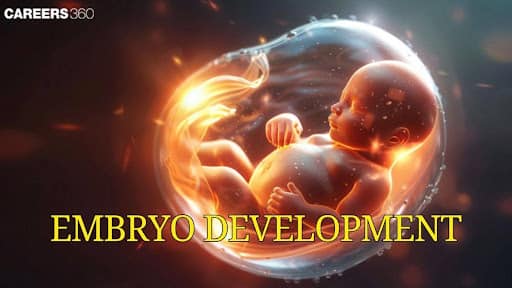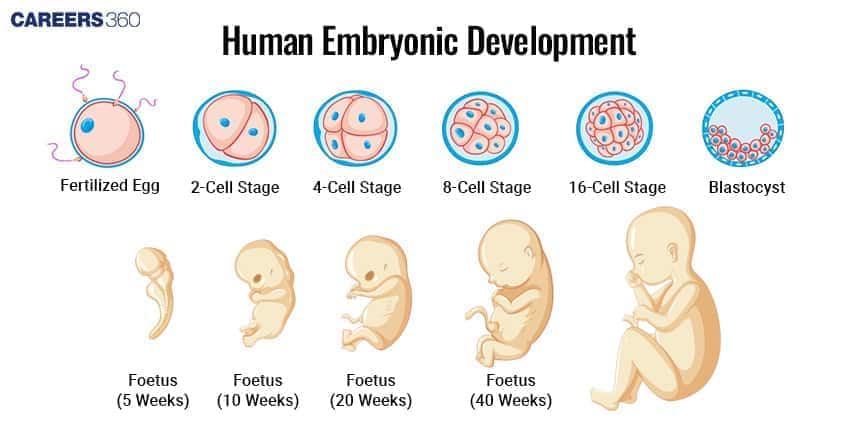Embryo Development: Definition, Stages, Types and Examples
Embryo development is a complex process that begins with fertilisation, followed by cleavage, morula, blastocyst, and organogenesis. The embryonic stages in the human embryo are characterized by cell differentiation and the development of major structures. The field of embryology helps to understand how cells differentiate, forming the foundation for developmental biology.
This Story also Contains
- What is an Embryo?
- Embryo Development
- Stages of Embryo Development
- Timeline of Embryo Development
- MCQs on Embryo Development

It is necessary to study embryo development as it helps to explore the evidence of evolution, as similarities in embryonic stages in different species reveal common ancestors and evolutionary patterns. This knowledge deepens our understanding of growth during pregnancy and also helps in medical research, reproductive health, and evolutionary biology.
What is an Embryo?
The earliest developing stage of multicellular organisms that appears right after fertilisation and is before the stages of the fetus is the embryo. It's in this stage that rapid cell divisions and differentiation occur to lay a base for all the necessary structures and systems of the organism.
In human beings, it starts at conception and continues until the end of the eighth week of pregnancy. The beginning period is important in understanding the different stages of embryo development like fertilisation, early embryonic stages, gastrulation, neurulation, and organogenesis.
Embryo Development
Often, what we refer to as the process by which an embryo is formed starts in fertilisation, whereby the sperm fertilises the egg cell, and the outcome is a zygote. Such a cell contains all the genetic material needed to constitute a fully-fledged organism. In that zygote, rapid mitosis begins, resulting in the formation of a multicellular structure known as the morula.
This is when a morula transforms into a blastocyst, which then implants into the uterine wall. The embryonic development is considered early development when cells begin to differentiate and all the basic structures necessary for continued growth are established. This in itself forms a very important stage in the study of stages of embryonic development, especially when it comes to human embryo development.
Stages of Embryo Development
Embryo development occurs in several stages. It begins the fertilisation where sperm and fuses together to form a zygote. This is followed by cleavage, a series of cell divisions. The next stage is morula, a solid ball of cells which then forms a blastocysts, a hollow structure that implants into the uterus. Finally organogenesis, where cells differentiate and form the organ system of the body. The development of an embryo includes the following stages:
Fertilisation
The first appearance of the fertilised egg is when sperm and egg meet and this is followed by penetration, fusion and finally zygote formation.
Two genetic contributions, one from the mother and one from the father come together to provide the blueprint for the new organism.
Early Embryonic Development:
Cleavage: A zygote becomes a morula, followed by the blastocyst. The latter consists of the inner cell mass.
Implantation, where the blastocyst implants into the uterine wall under the influence of hormones produced in the mother.
Gastrulation
It is at this stage that the three germ layers ectoderm, mesoderm and endoderm form. The layers eventually develop into the tissues and organs in the body.
The importance of this stage is that it helps develop the body plan and initiates organogenesis.
Timeline of Embryo Development
The development of an embryo follows a timeline from fertilisation to the formation of a baby. Each stage has a defined time frame and plays a crucial role in the growth and development of the fetus. Tracking the timeline helps to check the development of the baby or detect any abnormalities during pregnancy.
Weeks after Fertilisation | Embryonic Development |
Week Three | Formation of three germ layers neural tube and notochord start forming. |
Week Four | Heart starts beating, arm buds and eye pits are visible. |
Week Five | Size ~ 4 mm and embryo development becomes C-shaped inner ear and pharyngeal arches form liver, pancreas, spleen, and gall bladder. |
Week Six | Size ~ 8 mm. The eyes and nose form and leg buds and hand paddles appear. The stomach and kidneys start developing. |
Week Seven | Size ~ 13 mm. The respiratory system, lymphatic system, and sex organs start developing; arms and legs grow, and fingers and toes appear. |
Week Eight | Size ~ 20 mm. The external ears, nipples, and hair follicles start developing, and most organs are formed. |
MCQs on Embryo Development
Q1. Ontogeny repeats phylogeny was stated by
S.Fox
A.Wallace
C.Darwin
E.Haeckel
Correct answer: 4) E. Haeckel
Explanation:
Ernst Haeckel proposed the biogenetic law, which states that "ontogeny repeats phylogeny." This means that the development of an organism (ontogeny) reflects the evolutionary history of its species. Regardless, this concept is not entirely accurate, as modern evolutionary biology recognizes that embryonic stages are influenced by both ancestral traits and adaptations to current developmental needs.
Hence, the correct answer is option 4) E. Haeckel.
Q2. In the following questions, a statement of assertion (A) is followed by a statement of reason (R)
(A) If both Assertion & Reason are true and the reason is the correct explanation of the assertion, then mark A
(B) If both Assertion & Reason are true but the reason is not the correct explanation of the assertion, then mark B
(C) If Assertion is true statement but Reason is false, then mark C
(D) If both Assertion and Reason are false statements, then mark D
Assertion: Even though two animal species' adults may not resemble one another very much, their embryos often do.
Reason: For instance, young chicks and young rabbits are nearly indistinguishable from one another, yet adults may be easily told apart.
A
B
C
D
Correct answer: 1) A
Explanation:
Studying an individual plant or animal's developmental history provides strong support for the hypothesis of evolution. Every organism replicates the evolutionary history of its predecessors during the course of its own development. Even though two animal species' adults may not resemble one another very much, their embryos often do. For instance, young chicks and young rabbits are nearly indistinguishable from one another, yet adults may be easily told apart.
Hence, the correct answer is Option 1) A.
Q3. Which of the following statements are correct?
Statement 1: Unborn or unhatched organisms that are in the early stages of development are called embryos.
Statement 2: The growth and development of embryos happens in stages. The physical characteristics of an embryo change during its growth. Some features become more focused. Some features vanish.
Statement 3: In general, the early stages of development in related species' embryos share more characteristics than the later stages.
Statement 4: There may be similarities between the embryos of different species that are not apparent when the organisms are completely developed. Numerous of these resemblances are homologous traits. These characteristics demonstrate the species' evolutionary relationships.
Statements 1 and 2 are correct but statements 3 and 4 are incorrect.
Statements 1 and 3 are correct but statements 2 and 4are incorrect.
Statements 1, 2 and 3 are correct but statement 4 is incorrect.
All the statements 1,2,3 and 4 are correct.
Correct answer: 4) All the statements 1,2,3 and 4 are correct.
Explanation:
Unborn or unhatched organisms that are in the early stages of development are called embryos. The growth and development of embryos happen in stages. The physical characteristics of an embryo change during its growth. Some features become more focused. Some features vanish. There may be similarities between the embryos of different species that are not apparent when the organisms are completely developed. Numerous of these resemblances are homologous traits. These characteristics demonstrate the species' evolutionary relationships. For instance, pharyngeal arches, also known as gill arches, are homologous features found in all embryos. These arches grow into gill-related structures in fish. These arches grow into the components of the ears and mouth in animals. Typically, at earlier stages of development, related species' embryos share more characteristics than they do at later stages.
Hence the correct answer is option 4) All the statements 1,2,3 and 4 are correct.
Also Read:
Frequently Asked Questions (FAQs)
Embryo development is the process by which a fertilized egg (zygote) develops into a mature embryo through cell division and differentiation.
The correct sequence is: Zygote → Proembryo → Globular stage → Heart-shaped stage → Torpedo stage → Mature embryo.
Embryo sac formation (megagametogenesis) occurs when a megaspore undergoes mitotic divisions to form a 7-celled, 8-nucleate female gametophyte.
Implantation is the attachment of the blastocyst (early embryo) to the wall of the uterus, where it embeds for further development.
An embryo sac contains one egg cell along with other supporting cells like synergids, antipodals, and a central cell.
